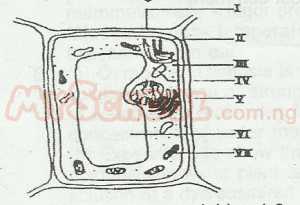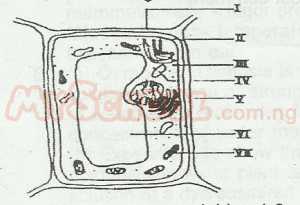Year :
2001
Title :
Biology
Exam :
WASSCE/WAEC MAY/JUNE
Paper 1 | Objectives
1 - 10 of 59 Questions
| # | Question | Ans |
|---|---|---|
| 1. |
Which of the following indicates that Euglena is plant? A. Conspicuous 'eye' spot B. Presence of gullet C. Limited movement D. Presence of starch grain |
D |
| 2. |
Which of the following is a tissue? A. Volvox B. Chlamydomonas C. Epidermis D. Paramecium |
C |
| 3. |
 The structure that produces ATP is labelled A. VII B. V C. VI D. I |
A |
| 4. |
 The structure labelled V is the A. cell wall B. nucleus C. endoplasmic reticullum D. mitochondrion |
C |
| 5. |
The major function of the cell membrane is that it A. delimits the cytoplasm B. synthesizes protein C. breaks down worn-out organelles D. is the site for photosynthesis |
A |
| 6. |
Carbohydrates are stored in the animal cell in the form of A. starch B. glycogen C. plastid D. maltose |
B |
| 7. |
A piece of yam weighing 1.0 gm was put into some salt solution. After 3 hours, it was removed and weighed. A. salt solution is more concentrated than the cell sap of the yam. B. cell sap of the yam is more concentrated than the salt - solution C. salt solution has the same concentration as the cell sap of the yam. D. the yam lost some water molecules to the salt solution. |
B |
| 8. |
A major reason why the red blood cells can survive in the blood is that the A. blood plasma and the red blood cells are isotonic B. red blood cells are hypotonic to the plasma C. the red blood cells are hypertonic to the blood plasma D. the red blood cells receive digested nutrients |
A |
| 9. |
Which of the following phenomena affects plants growth in an alkaline soil? A. Excessive plasmolysis B. Excessive transpiration C. Excessive sunlight D. Poor drainage |
D |
| 10. |
A red blood cell haemolyses when placed in a hypotonic solution because A. it contains haemoglobin B. the cytoplasm is less dense C. the cell lacks a wall D. its pigment has a high affinity for water |
B |
| 1. |
Which of the following indicates that Euglena is plant? A. Conspicuous 'eye' spot B. Presence of gullet C. Limited movement D. Presence of starch grain |
D |
| 2. |
Which of the following is a tissue? A. Volvox B. Chlamydomonas C. Epidermis D. Paramecium |
C |
| 3. |
 The structure that produces ATP is labelled A. VII B. V C. VI D. I |
A |
| 4. |
 The structure labelled V is the A. cell wall B. nucleus C. endoplasmic reticullum D. mitochondrion |
C |
| 5. |
The major function of the cell membrane is that it A. delimits the cytoplasm B. synthesizes protein C. breaks down worn-out organelles D. is the site for photosynthesis |
A |
| 6. |
Carbohydrates are stored in the animal cell in the form of A. starch B. glycogen C. plastid D. maltose |
B |
| 7. |
A piece of yam weighing 1.0 gm was put into some salt solution. After 3 hours, it was removed and weighed. A. salt solution is more concentrated than the cell sap of the yam. B. cell sap of the yam is more concentrated than the salt - solution C. salt solution has the same concentration as the cell sap of the yam. D. the yam lost some water molecules to the salt solution. |
B |
| 8. |
A major reason why the red blood cells can survive in the blood is that the A. blood plasma and the red blood cells are isotonic B. red blood cells are hypotonic to the plasma C. the red blood cells are hypertonic to the blood plasma D. the red blood cells receive digested nutrients |
A |
| 9. |
Which of the following phenomena affects plants growth in an alkaline soil? A. Excessive plasmolysis B. Excessive transpiration C. Excessive sunlight D. Poor drainage |
D |
| 10. |
A red blood cell haemolyses when placed in a hypotonic solution because A. it contains haemoglobin B. the cytoplasm is less dense C. the cell lacks a wall D. its pigment has a high affinity for water |
B |